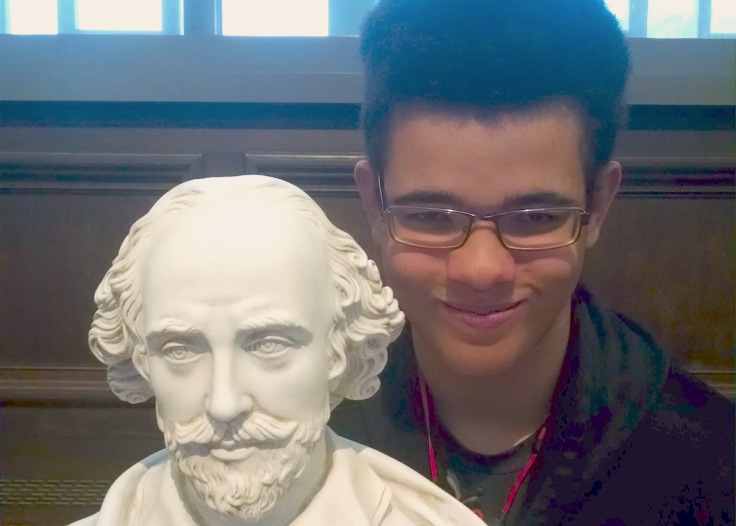Listen to Episode 3 – Student Performers with Daniel Bowers https://sallypal.podbean.com/mf/web/sgeydf/Ep_3_Student_Performers_with_Daniel_Bowers.mp3
Shakespearean Moments
As the National Endowment for the Arts (NEA) comes under fire and the conversation for saving the arts in schools pops up on social media yet again, I want to introduce you to Daniel Bowers. Daniel is a well-rounded kid with a hunger for performing. He sings in choir, he acts on the stage. It would not surprise me to see him take up tap dancing. Despite being a 6’4” 15-year-old football player, Daniel speaks as eloquently on acting as any acting coach. He credits his stage experience with building confidence, making friends, learning how to solve problems under pressure, and developing an appetite for working with a diverse group of people creating a big collaborative work from the ground up. These all seem like the things we would want kids to learn to succeed in life, never mind having a career as an actor. I met Daniel when he entered 6th grade at the school where I taught theater arts. He seemed to be a quiet kid but there was a lot going on in that busy brain. In addition to being an avid reader, Daniel is interested in history, languages, and making people laugh with the cast of characters living in his head. He auditioned for Alice in Wonderland. After landing a small role, he set about creating a character that stole the show. Without mugging, or ad libbing, Daniel did something adult actors occasionally miss. He took what was on the page along with a small bit of directing, and he created a memorable moment within the context of a story. I have directed Daniel in two other plays and it has always been a joy. The last show, Juliet Rescue, was a new piece written by my son, Will Inman (episode 2) and me. Daniel played “Young Will Shakespeare”. He eagerly took on the role and, while speaking in the Bard’s style, he created several hilarious moments that added warmth to the play. When I retired from teaching a year ago, I told him to come visit me in Virginia and I would take him to the Folger Library in Washington DC. It is the foremost Shakespearean library in the world. Daniel and his mom took me up on my offer and we spent quite some time learning about the collection at the Folger. I can imagine Daniel on stage there one day. But for now, I am thrilled to have seen him savor another kind of Shakespearean moment. There are lots of kids who benefit from performance experience. They are girls and boys, shy and outspoken, theatre nerds and athletes, straight-A students and strugglers, and everyone in between. They are a generation of leaders and innovators. And we want them all to have Daniel’s confidence. I hope you will enjoy Episode 3 of SallyPAL with Daniel Bowers.
Listen to Episode 3 – Student Performers with Daniel Bowers https://sallypal.podbean.com/mf/web/sgeydf/Ep_3_Student_Performers_with_Daniel_Bowers.mp3

Listen to Episode 3 – Student Performers with Daniel Bowers https://sallypal.podbean.com/mf/web/sgeydf/Ep_3_Student_Performers_with_Daniel_Bowers.mp3












